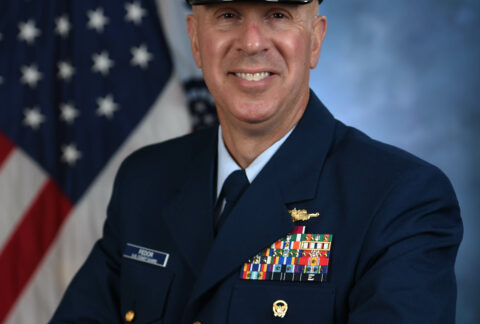General Ramsés Rueda Rueda, commander of the Colombian Air Force, spoke with Diálogo during his May 2021 visit to U.S. Air Forces Southern/12th Air Force (AFSOUTH) for the conclusion of Red Flag-Rescue, a premier combat search and rescue exercise. The exercise, with the participation of the Colombian Air Force (FAC, in Spanish), Germany, and France, took place at Davis-Monthan Air Force Base in Tucson, Arizona.
Diálogo: The FAC, which is 102 years old, has a new institutional mission planned through 2042. What is the importance of this new mission?
General Ramsés Rueda Rueda, Colombian Air Force commander: The world is changing rapidly, threats are growing, and some threats persist. Some threats are emerging on the continent; this requires democracies in the region to unite, become stronger, and confront those threats together.
The Colombian Air Force needs to be interoperable to [work] with powers such as the United States, which has been our great ally for a long time. And to be interoperable, you first need a strategy, and the strategy starts from rethinking our mission and rethinking the air force’s institutional vision. We set out to modernize our force, and we are thinking about what our force would look like in 2042.
This is why an institutional vision should be interoperable, but it also highlights innovation as one of the key factors in the development of the force. It highlights the acquisition of new equipment and building a capacity that is a deterrent capacity, that is real, that is credible, but above all that is sustainable.

Diálogo: You said the FAC seeks to become a “preferred, international benchmark.” What strategies are you implementing to achieve this projection?
Gen. Rueda: To become a benchmark, you must exercise leadership, and leadership is built on the ability to acquire new equipment, better standards, or better training, to make your capabilities visible. But also, a leadership that is capable of attracting willingness, a leadership that is capable of integrating those capacities in the region, and a leadership that allows us to work together.
It’s important for us to attract this willingness and exercise leadership in the region, taking the initiative to confront these threats. So we believe that if we manage to combine all that willingness, we can create great synergy and combat those threats that we have in the region more effectively.
We cannot do it alone, but thanks to the years of experience that we have in fighting internal threats and national threats, we can share our experience. We can help other countries rebuild capabilities or increase their capabilities, and obviously, under our leadership we can all fight.
Diálogo: What does participating in Red Flag-Rescue mean for the FAC?
Gen. Rueda: Our first approach to these exercises was in 2012, when we took part in Red Flag with Kafir aircraft, with two tanker aircraft that we had at that time; that was the beginning of a strategy to build capabilities, to build standards, to make ourselves more interoperable. After a series of exercises that we carried out in the United States, we came back to participate, and this time we came with an A-29 and our electronic warfare aircraft.
The purpose of our visit is to train other crews who hadn’t had that opportunity. [It’s] to achieve the standards that we need, to become more interoperable with other teams, to begin to exploit the electronic warfare capabilities that we have, to integrate them with those other capabilities that we have with the A-29s, so that we can effectively take part in crew rescues, in combat, for example.
But beyond that, it’s about raising our standards and our techniques, tactics, and procedures, so that we can not only continue to confront threats in the country, but also join the United States and confront other actors in the region — actors who are evil, competitors — and continue to fight against international threats such as narcotrafficking.
Diálogo: What type of combined operations does the FAC carry out to confront narcotrafficking and transnational threats inside and out of the national territory?
Gen. Rueda: Colombia has worked to build cooperation agreements with countries in the region. We have agreements with neighboring countries, with Ecuador, Peru, Brazil, Panama, to train our crews, to train our personnel, so that we can communicate better, to raise our standards. But we went from doing training, as we also do with countries in Central America and the Caribbean, to doing combined operations. And combined operations seek to yield results. Training raises our standards, but operations enable us to really combat the enemy.
So we have a firm intent in the Colombian Air Force to continue building agreements, to move from training to combating threats and the transnational threats that are affecting us all. We’ve worked very hard with Guatemala, and we’ve had important results. We have severely affected narcotrafficking, and we are calling on other countries to work together in combined operations, so that we can really create an invincible shield to counter the many planes that continue to fly between South and Central America transporting cocaine.
Diálogo: The FAC will carry out operational exercise Angel of the Andes (Ángel de los Andes) in August 2021. What is the importance of this exercise at the national and international levels?
Gen. Rueda: After having participated in exercises in the United States, where we’ve come to learn a lot, the results are beginning to show. We went from being observers to taking part in exercises, and now we are leading exercises.
This year is our turn to lead an important exercise, which is Cooperation 7 Angel of the Andes, [where] the two merge under our leadership, with the participation of several countries in the region, including the United States, always present as our most important partner. We are going to carry out a combined exercise in Colombia, in different locations, where we will simulate two complex situations, a tsunami and an earthquake; and all together we are going to address that situation.









